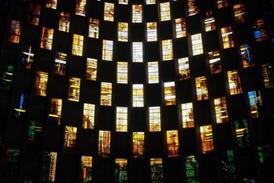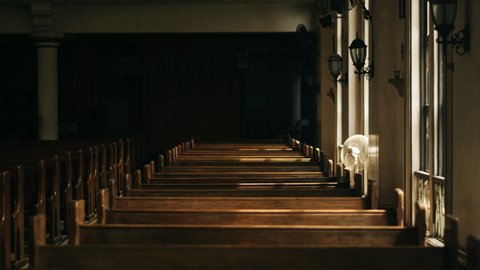More traditional styles of worship are gaining popularity, in contrast with the modern norm of trendy pop-rock worship bands, minimalist décor and warehouse-style buildings. Erik Strandness reflects on his desire for awe, majesty and beauty when attending church
I love my church. It’s a growing congregation of Godly people led by a Jesus-loving staff. Our church building is comfortable, contemporary, and clean. We have video screens on stage for those who arrive on time and video monitors in the back for those who arrive late. We have hot coffee in the winter and cold brew in the summer. We have an excellent praise band and a gifted pastor who inspires me weekly, yet… I long for a sacred space. What’s my problem? What am I looking for?
My church fills me to the brim intellectually and emotionally but leaves my holiness glass half-full. I learn about Jesus and sing his praises, but I never get close enough to touch the hem of his robe. Church often feels like a theatrical program featuring a spoken word artist and an opening band. I get entertained by uplifting music and a solid “God talk”, and if it’s communion Sunday, I get dinner and a show. But sadly, after the service, I find myself questioning the choice of music and the relevance of the sermon, instead of asking myself if I met Jesus that day.
I was raised in a Lutheran church with a cross, altar, communion rail, choir loft, and baptismal font, all tastefully arranged in a functionally minimalist Scandinavian style. It provided a space that elicited a sense of authority, order, and significance… but not awe. Later in life, I attended a church that met in a refurbished old movie theater, which, while filled with people on fire for Jesus… still left me cold. I felt the presence of the Holy Spirit in each of these venues, but I sensed that the Comforter was uncomfortable calling them home.
Sacralising Time and Space
Holy means set apart, so for a place to be sacred, it must be completely different, changing our orientation to space and time. A divine space occupies a specific geographical location yet transcends its physical limitations by allowing our minds to soar to the heavens. Sacred space requires that we be on time, but once inside, time stands still, and we no longer need to check our watches because we are caught up in the moment. A holy place assures us that the Most High does not live in houses made by human hands and that the eternity set in our hearts will find its moment in the Son. Therefore, if a church wants to evoke a sense of the sacred, it should incorporate décor, ritual, and liturgy that reveal the hands of the One who wove the fabric of space and time.
Garden Variety Church
A temple is a place where God and man meet. In the Judeo-Christian tradition, the archetypal meeting place was the Garden of Eden. This explains why God instructed his Chosen People to build and furnish the Tabernacle and then the Jerusalem Temple in ways that would remind them of their Edenic past. God’s detailed instructions concerning the architectural layout and interior decorations of the Tabernacle and Temple should alert us that the design of holy space matters to God. Therefore, we should make every effort to give our sacred spaces a similar divine feng shui.
I realize that building projects of this magnitude are financially prohibitive, and retrofitting current structures may be the only option for a church body. This raises an important question: How do we make a church holy? How do we make a serviceable structure sacred? How do we make a workable space worshipful? Is it possible to transform a garden-variety building into an Eden?
Body Language
I have generally assuaged my sacred space concerns by reminding myself that the church isn’t a building but a people. A sentiment that finds Biblical support in the Hebrew word קְהַ֖ל (qahal) and the Greek word ekklēsia, both of which refer to an assembly or congregation of people gathered together for a specific purpose. St. Paul further elaborated on this idea by describing the church as a Body composed of various members. Interestingly, however, Paul didn’t complete his metaphor by listing vital organs, such as the heart, lungs, and liver, but instead chose non-essential body parts, such as the feet, ears, eyes, and nose, whose primary task was to interface with the outside world. Is it possible that Paul wanted to use a metaphor that not only emphasized corporal integrity but also reminded us that a Body that doesn’t meaningfully interact with the outside world is fundamentally dead?
What if a church’s holiness was known by its body language, in the way it moves, listens, sees, and smells? If this is true, perhaps the church should supplement its usual calisthenic worship regimen of sitting for a sermon and standing to sing, by adding healthy reps of bowing, kneeling, and genuflecting. Maybe we should periodically put the praise band on mute and listen intently for that still small voice. Perhaps our churches would take on an air of holiness if we accentuated the aroma of our coffee-scented sanctuary with a hint of incense. What if the best way to address the church’s progressive scriptural illiteracy was to spend less time reading praise song lyrics off a video screen and more time contemplating beautiful stained-glass windows and icons artfully narrating important Biblical stories? Maybe if we received communion regularly, the holy taste in our mouths would linger longer, guaranteeing that Jesus remains on the tip of our tongues for the rest of the week. Finally, what if the inspiring sermons, carefully crafted to make the Bible relevant to everyday life, were delivered by pastors wearing vestments instead of khakis as a reminder that the connections they were making were sacred?
Read more:
How should we respond to church scandal?
What the Church can offer someone suffering with depression
Rethinking mental health and the church
Sounds of Silence
My daughter is uncomfortable in a church service, yet is moved when she enters a vacant cathedral. Holiness, for her, isn’t found in a church overflowing with murmuring congregants but in an empty, sacred space where she is privy to the sounds of silence. However, her enchantment cannot be found in just any church; the building must be old, ornate, and expository. What is it about these three characteristics that evoke the sense of the sacred within her?
First, the historicity of a great cathedral gives it an air of invincibility that reassures us that the gates of hell have yet to prevail. It will have hosted hundreds of years of worship and been privy to thousands of prayers, each one seeping deeper and deeper into the very fabric of the building so that even when you are alone, the stones still cry out. Second, while the exterior of a cathedral evokes physical impregnability, its delicately crafted interior invites spiritual vulnerability. The outside walls protect from the encroaching powers of this dark world, but the interior welcomes those who have been broken by the spiritual forces of evil. Third, a cathedral is expository because it narrates the old, old story of Jesus and his love architecturally, structurally, and decoratively.
Overflow Seating
Cathedrals are structures that were meant to be holy from the moment they were conceived, and while it is difficult for humans to escape the sin of pride, I suspect these great churches, rather than vanity projects, were sacrificial labours of love offered to a God who had sacrificed everything for them. Maybe one of the reasons a cathedral feels like such a holy place is less about its majesty and more about the scores of people who helped craft it. The sacredness arises not from the beautiful accoutrements but from the anointing conferred by the laying on of a thousand craftsmen’s hands. In his excellent book, Living in Wonder, Rod Dreher, commenting on one of Moldavia’s famed painted churches, described the experience this way:
“You don’t have to work to feel the presence of God here. The hands of God-loving artists have done all the labour for you. All you have to do is receive it and allow wonder to overtake you.”
While ancient cathedrals bring to mind the hands that went into their construction, they also remind us of the many Christians who filled the pews over the years. Interestingly, churches have historically honoured the dead in Christ by associating themselves with graveyards, crypts, and columbariums, not to make it easier to sing dirges to the dead, but to effortlessly join the heavenly choir and worship the God of the living. I’m not suggesting that we once again gather in graveyards but rather intimating that our sacred spaces would feel larger if we provided overflow seating for the great cloud of witnesses surrounding us.
Comrade in Arms
The moment in the church service my family finds the most uncomfortable is the greeting. It may well be because we suffer from social anxiety, but as my daughter pointed out, it may also be that it distracts from the sacredness of the church space. A handshake or a fist bump feels sacrilegious because it interrupts holy vertical worship with horizontal white noise. She made an interesting distinction between community and camaraderie, defining community as the social expression of the church and camaraderie as our shared primal longing for God. I believe the Christian community is vital, but it needs to be put in proper perspective. Community is fostered in the foyer, while comradery is sanctioned in the sanctuary. Handshakes and hugs are essential manifestations of community, but standing side-by-side, raising hands heavenward in worship, makes us comrades in arms.
One of the challenges for the church is welcoming visitors. Generally speaking, we do a good job of seeking out unfamiliar faces, reaching out a hand to greet them, and then engaging them in conversation. However, the problem is that we tend to see them as outsiders who would benefit from being brought into our community instead of comrades, jointly working out our salvation with fear and trembling. It takes a lot of courage for a seeker to walk through the church door, so we need to ask ourselves if we are signing them up for a social club or helping them seek the face of God.
Community gives visitors the sense that the problem has been solved. Comradery, conversely, indicates that we are figuring it out together. It’s difficult for a seeker to seek amongst people who are confident they have found. Christians shouldn’t be spectators watching others wrestle with God but tag team members tapping in to share in the struggle. Jesus isn’t a mascot but the lover of our souls; we don’t declare our salvation by rocking the community swag but by wearing broken and contrite hearts on our sleeves.
Get access to exclusive bonus content & updates: register & sign up to the Premier Unbelievable? newsletter!
Fuelling the Fleet
Jesus said he was the new Temple; Paul told us that our bodies are temples, and the first Christians worshipped in homes. So why do we need churches with all the bells and whistles? Aren’t they distractions from true Christian worship?
Jesus commanded his followers to take the Good News to the ends of the earth, which meant getting off their triclinium and hitting the road. But as the area they evangelised expanded, they needed to build outposts to mark God’s territory and serve as recharging stations for those who pushed the Kingdom’s boundaries. However, because of Christ’s work on the cross, these outposts no longer had to be temples where God and man could meet but rather structures reminding them they had already met.
At Jesus’ crucifixion, the veil was torn, and our sinful bodies were washed clean enough to house the Holy Spirit, transforming us into mobile tabernacles capable of hitting the Great Commission Road and bringing Jesus to Judea, Samaria, and the ends of the Earth. However, our Gospel vehicles, constructed of flesh and bone, would require periodic refuelling. So, rather than distractions along the Gospel highway, every newly built church was a sacred service station dispensing the holy petrol necessary to keep the entire priestly fleet of believers on the road.
Leaving with Jesus
The early church met in houses that were structurally plain, acoustically limited, and ornamentally challenged, yet were made holy by sharing the Lord’s Supper. If true, the Body and Blood would be a good place to begin our holiness project. Protestants can start by making it the centrepiece of weekly worship, while Catholics can welcome any Christian saved by Jesus to sit side-by-side with them at the communion table.
Protestants have issues with whether the bread and wine represent the actual Body and Blood of Christ, but they have to admit that every time a Catholic exits the church, they take a bit of Jesus with them. An Evangelical may hear an excellent sermon and be moved by a well-performed praise song, but there is no guarantee they will leave with anything but some new Bible knowledge and a musical high. Catholics and Protestants can be critical of a poorly delivered homily or sermon and an amateurish musical performance. Still, only one regularly leaves filled with Jesus.
Evangelical communion, especially in big churches, lacks reverence for the Body and Blood because it is administered in pre-packaged, all-in-one communion dispensing units blessed not by the clergy but by a factory inspector’s stamp of approval. I realize that administering the elements to large numbers of people is a technical challenge, but shouldn’t we spend less of our resources upgrading our audiovisuals and instead invest in better ways to administer communion so it doesn’t feel like take-out? I find it interesting that when we have a special Guest in our homes, we bring out the good China, yet when we celebrate the Lord’s Supper, we settle for paper plates and plastic cups.
Catholics, on the other hand, take the Body and Blood that was broken and shed for the forgiveness of the sins of the entire world and confine it to a monstrance. The most potent medication in the Great Physician’s therapeutic arsenal is locked away in a medicine cabinet only to be dispensed by licensed priestly pharmacists to those who chose Catholicism as their primary holiness provider. I enjoy attending Mass with my Catholic son, but I am sad we cannot take the Lord’s Supper together. I sit in the pew, worshipping the God of the universe with fellow Christians, yet I cannot share in the very ritual that transformed homes into houses of the holy. Shouldn’t the same practice that made the early Christian house churches sacred be the first thing on our holy to-do list?
Holiness Crisis
We are in the midst of a profound meaning crisis in the West, which can be more accurately described as a holiness crisis. When the world is just matter-in-motion, we miss the movement of the Holy Spirit, looking for sacred cows; we only see lame ducks.
We like to blame the culture for draining holiness out of the world, but maybe the church contributed by letting it leak out drip by drip. Wanting church to be relevant to our young people, we pulled them out of the sanctuary and sent them to the “youth service,” which looked more like a churchy Chucky Cheese. In a Patheos article titled, “Dear Church: An open letter from one of those millennials you can’t figure out,” Jonathan Aigner nicely articulates the problem:
“We don’t want to be entertained in church, and frankly, the church’s attempt at entertainment is pathetic. Enough with the theatrics. Enough with the lights, the visuals, the booming audio, the fog machine, the giveaway gimmicks, the whole production. Follow that simple yet profound formula that’s worked for the entire history of the church. Entrance, proclamation, thanksgiving, sending out. Gathering, preaching, breaking bread, going forth in service. Give us a script to follow, give us songs to sing, give us the tradition of the church, give us Holy Scripture to read. Give us sacraments, not life groups, to grow and strengthen us.”
Young people want a spirituality that is set apart and not more of the same. They are tired of worshipping in the glare of the spotlights and want to bathe in the glow of candles. They think that holiness shouldn’t be measured in decibels but by whether or not you can hear a pin drop. They want a sacred space tended by a holy man and not a classroom presided over by the coolest teacher. If we don’t get holiness right, our young people will have no reason to consider checking any religious preference box other than “none of the above.”
Sanctuary
In the Disney movie, The Hunchback of Notre Dame, Quasimodo saves Esmerelda from being burned at the stake by taking her to a cathedral and invoking sanctuary because, in a holy place, the powers of the world are disarmed. If the meaning crisis is a holiness crisis, the church should strive to be sacred enough to provide refuge for those who feel their lives have no purpose. The world can only offer primal scream therapy to the hopeless, but holy space has the proper acoustics for them to cry, “Sanctuary!”
The church is often depicted as a hospital for sinners. However, unlike a real hospital, where you wait in the reception area before seeing a doctor for treatment, you can enter a church to see the Great Physician and receive healing by sitting in his Holy waiting room. The true test of sacred space may be whether it can be therapeutic even when the staff is on a break.
Suggestion Box
I’m not converting to Roman Catholicism or Eastern Orthodoxy but merely pointing out that our Evangelical allergy to these traditions has left us without holy spaces and reduced the church experience to talk and a tune, which, rather than set us apart, makes us a dime a dozen. We need to up our game and spend more effort making our churches into sacred spaces because encountering holiness is important for both the seeker and the saved. A sermon or a praise song may reveal a seeker’s God-shaped hole, but that hole is best filled in a space where the Holy Spirit isn’t in competition with the spirits of the world. The saved, on the other hand, need holy spaces to rekindle the fire of their baptism so that when they take the Gospel to the ends of the Earth, they will have enough spiritual warmth to take off the chill of a world gone cold.
Holiness in human hands is always in danger of becoming holier-than-thou, so while we need to remind people that we worship a Holy God, we must be careful how we implement our sacralising schemes. We must be careful not to make a place so holy that human entry is restricted or divine exit is prohibited. Sacred space was redefined when the Temple curtain was torn at Jesus’ crucifixion, making it not only possible for humans to enter the Holy of Holies and enjoy God’s presence but also freeing the Holy Spirit to reside in our bodies.
We must not squeeze God back into a Holy of Holies and sew the curtains shut. We must avoid the temptation to cage the Lion of Judah because when we do, our churches end up becoming zoos offering Jesus-sightings from a secure location rather than wildlife encounters with the God who isn’t safe but is good. Many will bristle at the idea of casting our pearls before swine by opening up our Jesus booth in the cultural black market. Still, if we don’t show people the Pearl of Great Price, they will never count the cost of selling everything to purchase it.
I’m sure that this article will upset both Protestants and Catholics alike. Still, I didn’t write it to nail theses to a Protestant church door or tack on more to a Catholic one but only to drop a few ideas about holiness into the Christian suggestion box for further consideration.
Erik Strandness is a physician and Christian apologist who practiced neonatal medicine for more than 20 years and has written three apologetic books. Information about his books can be found at godsscreenplay.com
























